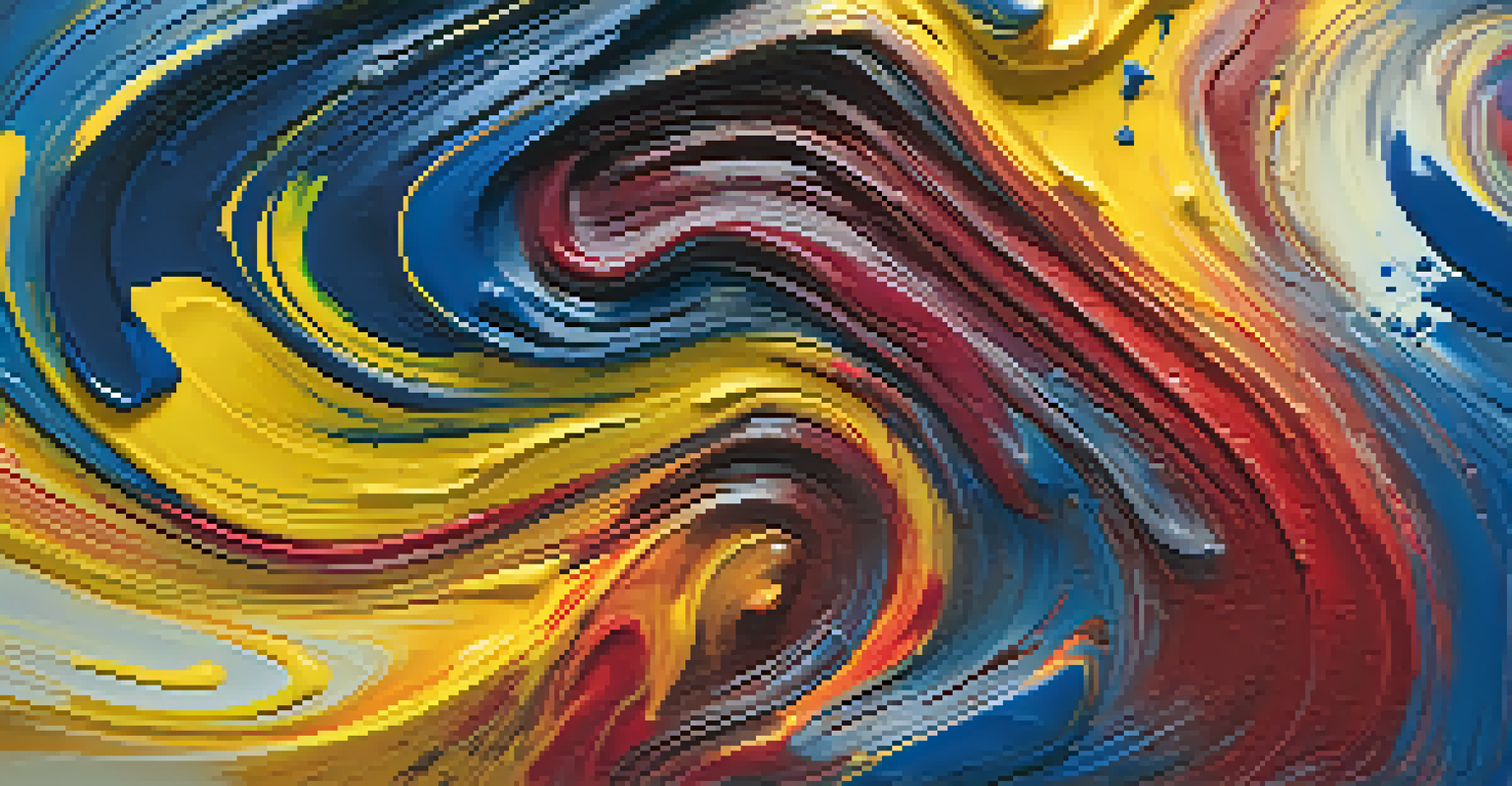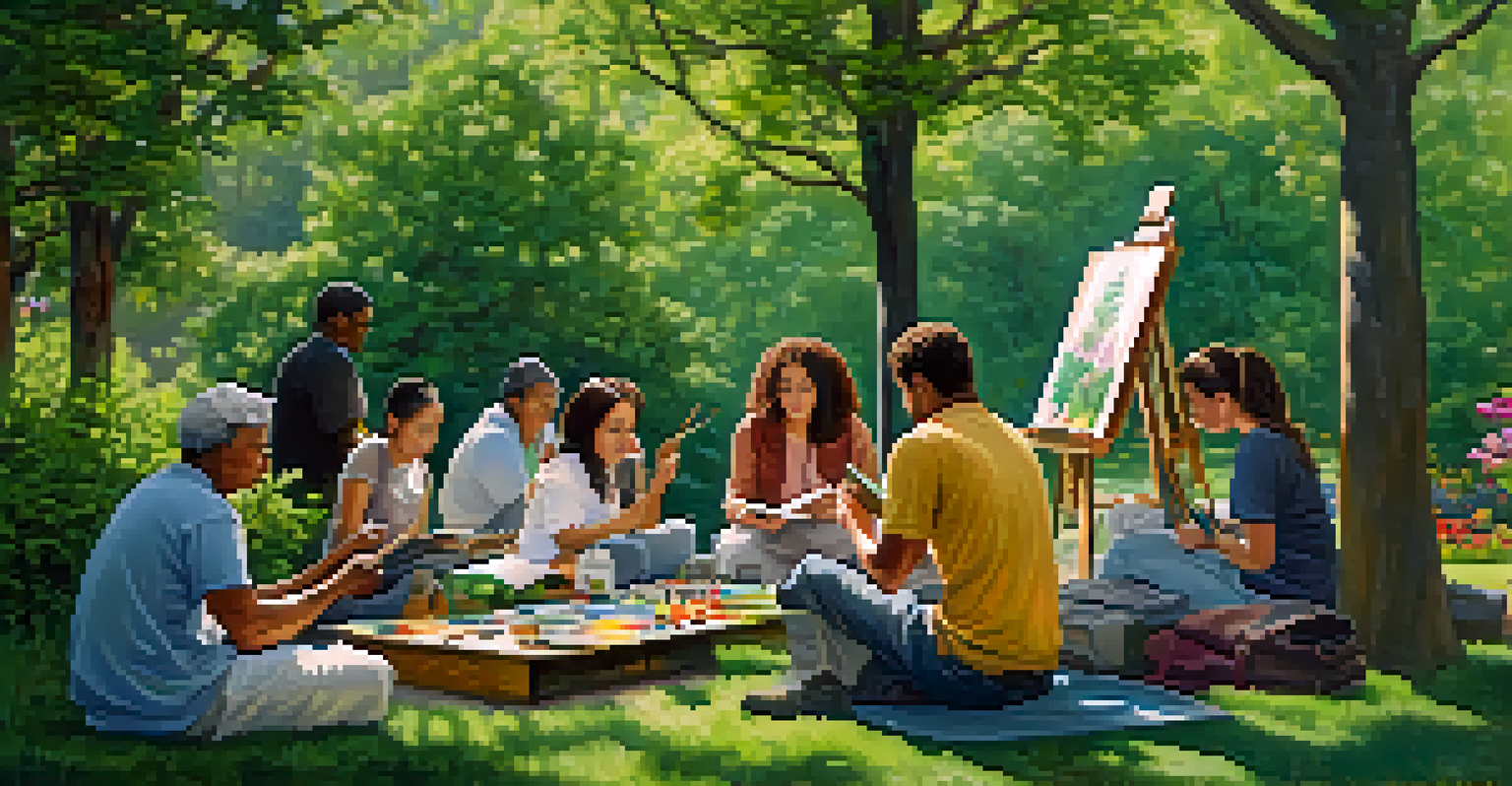Healing Arts: The Use of Entheogens in Therapeutic Art Practices

Understanding Entheogens and Their Role in Healing
Entheogens are natural substances that can induce altered states of consciousness, often used in spiritual or therapeutic contexts. These include plants and fungi like psilocybin mushrooms and ayahuasca, which have been utilized for centuries in various cultures. Their ability to facilitate deep introspection and emotional release makes them appealing for healing practices.
Psychedelics are a way to open doors to the inner self. They can help you see the world in a different light, and art can express those experiences.
As more people seek alternative therapies for mental health challenges, entheogens are gaining attention. They can help individuals confront trauma, anxiety, and depression by unlocking a creative flow that may otherwise be stifled. This connection between creativity and healing opens new avenues for artistic expression and personal growth.
In therapeutic art practices, the use of entheogens can enhance the creative process. By fostering a deeper emotional connection to art, individuals can explore their inner landscapes, leading to transformative experiences that promote healing and self-discovery.
The Intersection of Art and Psychedelic Experience
Art has always been a powerful medium for expressing complex emotions and experiences. When combined with the psychedelic experience induced by entheogens, this expression can deepen significantly. Artists may find themselves tapping into subconscious thoughts and feelings, translating them into visual or auditory forms that resonate on a profound level.

For instance, many artists report heightened perception and an expanded sense of creativity when under the influence of entheogens. Colors may appear more vibrant, and sounds can evoke strong emotional responses, allowing artists to create works that reflect their inner experiences. This blend of art and psychedelic exploration can lead to powerful therapeutic outcomes.
Entheogens Aid Emotional Healing
Entheogens can facilitate deep introspection and emotional release, helping individuals confront trauma and mental health challenges.
Moreover, art created during these experiences can serve as a therapeutic tool in itself. It acts as a visual diary of one's journey, providing both the artist and the observer insight into the healing process. This unique interplay between art and altered states can foster discussions around mental health and well-being.
Benefits of Integrating Entheogens in Art Therapy
Integrating entheogens into art therapy can lead to numerous benefits for participants. One primary advantage is the ability to access suppressed emotions, allowing individuals to confront and process trauma more effectively. This release can be liberating and pave the way for healing and growth.
Art is the most beautiful of all lies. It allows us to explore the truth of our experiences, particularly those influenced by altered states.
Additionally, the creative process stimulated by entheogens can enhance problem-solving skills and emotional resilience. Participants often report feeling more open-minded and connected to their surroundings, which can translate into a more profound understanding of their challenges. This newfound perspective can be crucial in overcoming personal obstacles.
Furthermore, the communal aspect of sharing art created during these sessions can foster a sense of belonging and support. Engaging with others who have undergone similar experiences creates a safe space for healing, reinforcing the idea that vulnerability can lead to strength.
Cultural Context: Historical Use of Entheogens in Art
Throughout history, various cultures have incorporated entheogens into their artistic and spiritual practices. Indigenous tribes in South America, for example, have used ayahuasca in ritualistic settings to access deeper wisdom and creativity. This integration of art and psychedelics reflects a long-standing understanding of their healing properties.
Similarly, artists like Henri Matisse and Wassily Kandinsky have drawn inspiration from altered states of consciousness, often influenced by their experiences with substances. Their work exemplifies how these experiences can profoundly affect artistic expression, pushing the boundaries of creativity and perception.
Art Enhances Psychedelic Experiences
Combining art with the psychedelic experience of entheogens allows for profound creative expression and therapeutic outcomes.
By recognizing the cultural significance of entheogens in art, contemporary practitioners can honor these traditions while exploring their own therapeutic potential. This connection to history reinforces the idea that art and healing are intertwined, offering valuable lessons for modern therapeutic practices.
Challenges and Considerations in Using Entheogens
While the potential benefits of using entheogens in therapeutic art practices are enticing, there are challenges to navigate. Legal restrictions around the use of certain substances can hinder access for those who might benefit from them. It’s crucial to approach this topic with awareness of these limitations within different jurisdictions.
Additionally, not everyone may respond positively to entheogens, and their use should always be approached with caution. Individuals with a history of mental health issues, such as schizophrenia, may experience adverse effects. Therefore, professional guidance and a supportive environment are essential to ensure safety during these explorations.
Ultimately, understanding the complexities of entheogen use in art therapy is vital. By acknowledging both the potential benefits and risks, practitioners can create informed, responsible practices that prioritize the well-being of participants.
Modern Therapeutic Practices Incorporating Entheogens
In recent years, there has been a resurgence of interest in the therapeutic potential of entheogens. Modern practices are emerging that blend traditional wisdom with contemporary psychological techniques. These approaches aim to provide a safe and structured environment for individuals seeking alternative healing methods.
For instance, some therapy centers now offer guided sessions where participants can explore artistic expression while under the influence of entheogens. These sessions often include preparation and integration phases to help individuals make sense of their experiences. This support system can enhance the therapeutic benefits of the process.
Cultural Roots of Entheogens
Various cultures have historically integrated entheogens into their artistic and spiritual practices, highlighting their healing properties.
As research continues to uncover the healing properties of entheogens, it is likely that their integration into therapeutic practices will expand. This evolution may lead to more widespread acceptance and understanding of how art and psychedelics can work together for healing.
The Future of Healing Arts and Entheogens
Looking ahead, the future of healing arts involving entheogens holds great promise. As societal attitudes toward mental health and alternative therapies continue to evolve, there is potential for greater acceptance and integration of these practices. This shift could pave the way for innovative therapeutic models that prioritize creativity and holistic healing.
Increased research funding and studies exploring the effects of entheogens on mental health can further legitimize their use in therapeutic settings. By documenting the positive outcomes and experiences of participants, we can build a stronger case for their inclusion in mainstream mental health practices.

Ultimately, the intersection of healing arts and entheogens invites us to rethink traditional approaches to therapy. By embracing creativity and exploring altered states of consciousness, we may unlock new pathways to healing that empower individuals on their journey towards well-being.